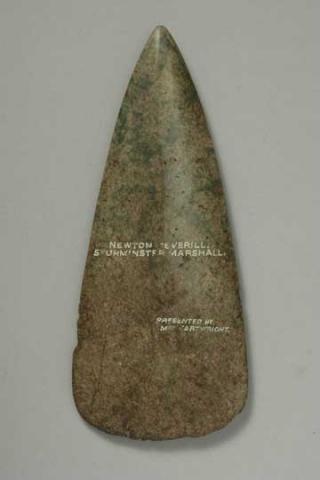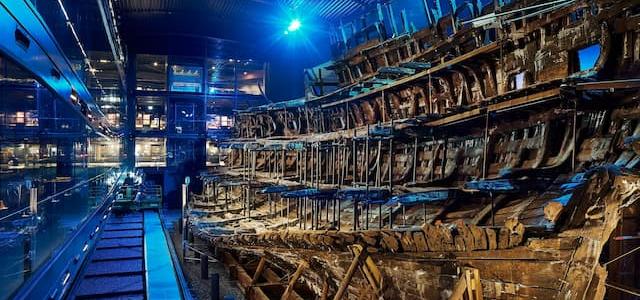
Jade axe stays in the UK
Dorset County Museum successful in purchase of 6,000 year old jade axe-head.

A polished jade axe-head dating from the early Neolithic, found at Newton Peverill in the Stour Valley, will now stay in the UK following its successful purchase by Dorset County Museum.
The Department for Culture Media and Sport placed a temporary export bar on this axe-head in January 2007. This gave the opportunity for a museum in this country to purchase at an agreed price of £24,000, from Rupert Wace Ancient Art Limited.
This museum is pleased to have had the opportunity for purchase, which has now been achieved in July 2007 by the Dorset Natural History and Archaeological Society for the Dorset County Museum with assistance from the National Heritage Memorial Fund (£14,000) and the MLA/V&A Purchase Grant Fund (£8,000).
Carole Souter, Director of the NHMF, said: “This axe-head has a long and fascinating story, having travelled across Europe to find its final resting place in Britain. It is wonderful news that this grant from the National Heritage Memorial Fund has helped ensure future generations can enjoy learning about it.”
The Newton Peverill axe-head, found in an area of outstanding archaeological importance, is considered to be one of the finest examples of its type in Britain. The jade itself comes from an outcrop in the foothills of the Italian Alps and the axe-heads polished and finished at working sites in southwest France and Brittany. Brought to Britain nearly 6,000 years ago during the early Neolithic times, axe-heads like these would have been prized by the first pioneer farming communities and valued as community treasures, perhaps as symbols of power and for magical properties.
Fewer than 20 complete jade axe-heads are known from Neolithic Britain and only seven prehistoric objects of jade have been recorded in Dorset. Five of these are on display in Dorset County Museum. These items include a much corroded axe-head from Hambledon Hill, from the excavations in 1975 on the Neolithic causwayed enclosure, and a fine perforated jade pendant, dating to the late Neolithic to Early Bronze Age, from Wootton Fitzpaine.
The Newton Peverill jade axe-head is now on display in the entrance hall at Dorset County Museum, before permanent display in the award winning Archaeology Gallery.
Notes to editors
MLA/V&A Purchase Grant Fund
- The MLA/V&A Purchase Grant Fund is a government fund, established at the Victoria & Albert Museum (V&A) in 1881 as part of its nationwide work. 2006 marked the Fund’s 125th anniversary
- The annual grants budget, currently £1,000,000, is provided by the Museums, Libraries and Archives Council (MLA).
- The Fund supports the acquisition of objects relating to the arts, literature and history by regional museums, record offices and specialist libraries in England and Wales.
- Each year it considers some 300 applications and in 2006-07 awarded grants to 115 organisations, enabling acquisitions of over £4million to go ahead.
The Dorset Natural History and Archaeological Society
In 1846 the Dorset County Museum was founded to preserve and study the geology, natural history and antiquities of Dorset. In 1883 the newly designed and constructed museum buildings, including large exhibition hall and library, were opened for the display and study of growing collections, and a first Curator was appointed. In 1928 the Dorset County Museum Society combined with the Dorset Natural History and Archaeological Field Club to form the present Dorset Natural History and Archaeological Society which directs, with local authority support, the independent MLA registered Dorset County Museum. The DNHASociety promotes the preservation of Dorset history through collection acquisition and displays at the Dorset County Museum, research, fieldwork, publication (including academic monographs and the county journal) and education.
The DNHAS is a Charity, registration 1062400, and a Company, registration 3362107, and governed by a board of 12 Trustees, elected at the Annual General Meeting in June.
Long term care and display at Dorset County Museum
The jade axe-head will be placed, with other polished axe-heads of the Early Neolithic period of 4000 – 3000BC, on permanent display in the award winning Archaeology Gallery at Dorset County Museum. This Gallery contains many objects from sites and collections of national significance, including nearby key objects and material, from the excavation archives at Dorset County Museum, of the Early Neolithic enclosures at Hambledon Hill (excavations, 1974 – 1986, funded by and publication in production by English Heritage) and at Maiden Castle (most recently excavated in 1985 -1986, funded and published by English Heritage), both with excavation records and finds of particular significance in the study of the Early Neolithic of Northern Europe.
Further information
Peter J Woodward, Curator, peter@dorsetcountymuseum.org
Phone: 01305 262735
Dorset County Museum is supported by Dorset County Council
The Dorset County Museum
High West Street,
Dorchester,
Dorset DT1 1XA
Phone: 01305 262 735
The Dorset Natural History and Archaeological Society
Company registered in England No. 3362107. Registered Charity No. 1062400

